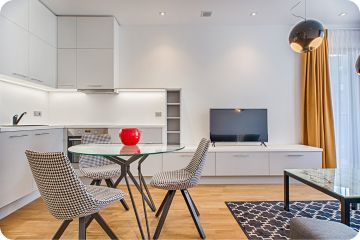Optimizing Real Estate Photos and Elevate your real estate game
Real estate photography plays a vital role in attracting potential buyers and showcasing properties in the best light. With over 90% of home buyers searching for properties online, high-quality photos have become a necessity in the real estate industry. In this article, we will explore the best practices for optimizing real estate photos and capturing stunning property images that can help sell a home quickly.
Table of Contents
The Value of Excellent Photos in Real Estate Listings
In today’s digital age, photos are the first impression that buyers have of a property. High-quality photos can not only grab the attention of potential buyers but also help build trust and credibility. Redfin found that homes with professional photos sold more quickly and profitably than those with amateur images. Therefore, investing in professional real estate photography can make a significant difference in the success of a sale.
Understanding the Technical Requirements for Real Estate Photography

Real estate photography requires a specific set of skills and equipment to capture the best photos of a property. A wide-angle lens is essential for capturing a room’s entirety, while a tripod can help stabilize the camera and reduce motion blur. Additionally, photographers must consider factors such as lighting, composition, and color balance to create visually appealing images. Understanding these technical requirements can help photographers take better photos and improve the quality of their work.
Tips for Capturing the Best Photos of a Property’s Interior
When photographing a property’s interior, it’s essential to capture each room’s unique features and layout. Here are some tips to keep in mind when capturing interior photos:
- Start with a clean and decluttered space.
- Make use of natural lighting to create a cozy and welcoming environment.
- Avoid shooting against windows or mirrors to prevent overexposure.
- To prevent camera shake and guarantee clear photos, use a tripod.
- Experiment with different angles and perspectives to highlight key features.
Techniques for Photographing a Property’s Exterior and Surrounding Areas
Exterior photos can be just as crucial as interior photos in attracting buyers. To capture stunning exterior photos, photographers must consider the property’s landscaping, architecture, and surrounding areas. Here are some techniques for photographing a property’s exterior:
- Shoot at the “golden hour” for warm and gentle lighting.
- Use a drone to capture aerial views of the property and its surroundings.
- Experiment with different camera heights and angles to capture unique perspectives.
- Focus on the property’s curb appeal, including landscaping, entryways, and outdoor spaces.
The Role of Natural Light in Real Estate Photography
In real estate photography, lighting is one of the most important aspects. Natural light can help create a warm and inviting atmosphere, but it can also be challenging to work with. Here are some tips for working with natural light in real estate photography:

- Shoot during the “golden hour” to achieve soft, warm lighting.
- Avoid shooting in harsh sunlight or during midday when the light is too bright.
- Use reflectors or diffusers to manipulate natural light and create even lighting.
- Experiment with different angles and positions to find the best natural lighting for each shot.
Enhance Real Estate Photos and Make Them Stand Out
Post-processing can help enhance real estate photos and make them stand out in online listings. Here are some common post-processing techniques used in real estate photography:
- Adjusting brightness and contrast to create a balanced and vibrant image.
- Removing unwanted objects or blemishes in the image.
- Adding warmth to create a cozy and inviting atmosphere.
- Using HDR techniques to create a well-lit and evenly exposed image.
Best Practices for Presenting ang optimizing Real Estate Photos
Organizing and presenting real estate photos in online listings is crucial for attracting potential buyers. Here are some best practices for organizing and presenting real estate photos:
- Start with a hero shot to grab the viewer’s attention and showcase the property’s best features.
- Use consistent lighting and colors throughout the photos to create a cohesive look.
- Organize the photos by room to make it easy for viewers to navigate.
- Use descriptive captions to highlight each room’s unique features.
- Include a floor plan to provide viewers with a better understanding of the property’s layout.
The Impact of Virtual and 3D Tours
Virtual and 3D tours have become popular tools for showcasing properties online. These tours can provide potential buyers with a more immersive and interactive experience, allowing them to explore the property as if they were there in person. Here are some tips for integrating virtual and 3D tours into real estate photography:
- Hire a professional to create a high-quality virtual or 3D tour.
- Embed the tour into the online listing to make it easy for viewers to access.
- Use the tour to showcase unique features of the property that may not be captured in the photos.
- Provide viewers with the ability to zoom in and out and navigate through the tour easily.
Common Real Estate Photography Mistakes to Avoid

Real estate photography can be challenging, and photographers must avoid common mistakes that can negatively impact the quality of their work. Here are some Common Real Estate Photography Mistakes to Avoid:
- Shooting in low light without a tripod, resulting in blurry images.
- Not capturing the property’s best features or unique selling points.
- Overediting photos, resulting in an unnatural or unrealistic look.
- Failing to declutter and clean the property before the photoshoot.
- Not using a wide-angle lens to capture the entire room.
Showcasing Successful Real Estate Photography and What Made Them Effective
Finally, let’s take a look at some case studies showcasing successful real estate photography and what made them effective:
- The use of natural lighting creates a warm and inviting atmosphere in a home’s living room.
- The use of aerial drone footage to showcase a property’s large backyard and surrounding areas.
- The use of a wide-angle lens to capture the entirety of a property’s open floor plan.
- The use of post-processing techniques to enhance a property’s curb appeal and landscaping.
- The use of virtual tours to provide potential buyers with an immersive and interactive experience.
Enhance your real estate photos by Pixelshouters
PixelShouters, being a real estate photo editing company, can help real estate photographers optimize their photos and make them stand out from the competition. With their expertise in post-processing techniques, they can enhance images by adjusting color and lighting, removing unwanted objects, and adding visual appeal to the property. By partnering with PixelShouters, real estate photographers can save time and focus on their core strengths while ensuring that their photos are optimized for maximum impact.
Conclusion
In conclusion, optimizing real estate photos is essential for attracting potential buyers and selling a property quickly and effectively. Real estate photographers should prioritize capturing the property’s best features, organizing photos by room, using consistent lighting and colors, and providing descriptive captions. They should also consider integrating virtual and 3D tours, avoiding common mistakes, and studying successful case studies. By following these best practices and techniques, real estate photographers can create stunning images that showcase a property’s unique selling points and ultimately help sell the home.
